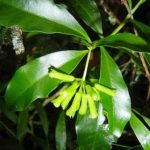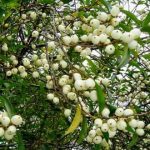TREE LIFE
February 2003
WHILE THE CURRENT FUEL CRISIS PERSISTS IT IS IMPORTANT TO CONFIRM WITH ANY OF THE COMMITTEE MEMBERS THAT THE SCHEDULED OUTINGS AND WALKS CAN ACTUALLY TAKE PLACE.
MASHONALAND CALENDAR
Tuesday 4th February: Botanic Garden Walk with Tom Müller. Meet in the car park at 4.45 for 5pm. The subject will be Acacias.
Saturday 8th February: Cathy Sharp will lead a fungi walk in the woodlands at Cleveland Dam. We will meet at 7.30am in the main car park. This is a treat not to be missed. But do please phone to confirm the walk.
Sunday 16th February: Because of the severe fuel shortages the venue has been changed to Dombashawa, to an area previously unexplored by the Tree Society; a rocky area on the lower slopes of Dombashawa, and if time and energy permit we may even be able to walk right round the mountain.
Saturday 22nd February: Mark’s Walk will be in the garden of Dr. A Heulin at 27 Glanmore Road, Chisipite.
Tuesday 4th March: Botanic Garden Walk.
MATABELELAND CALENDAR
Nothing has been arranged for February.
Contact Jonathan Timberlake if you would like to organize a future outing.
His telephone numbers are 09-286529 or 285761 (tel/fax) or
email <timberj@mweb.co.zw>.
SUBSCRIPTIONS FOR 2003/4
It is my unhappy duty to advise members of the proposed subscription for membership of the Tree Society from 1 April 2003.
The Committee gave this matter considerable thought at the most recent committee meeting.
With general price inflation now at 198% per annum, or a whisker below 200%, a 3-fold increase from $400 to $1200 would be consistent with general costs (if not our members’ incomes!). However, in practice, our main expense, which is the production cost of Tree Life, has increased faster than that. A number of measures have been taken to save money, specifically moving to another printer and making the font size smaller so as to cram more information in per page. However, we would not be able to survive on $1200 and therefore, reluctantly, we have decided to increase to $1500.
Even at this level, it will not be comfortable for the Society and we will be looking for sponsorship and/or donations which will hopefully enable us to carry on for another year. This will particularly be true if inflation now rises even higher, as it could possibly do. However, we do not want to scare members away. If there is any member (we are thinking especially of pensioners) who cannot afford the new rate, please get in touch with either Maureen or myself as the Society may be able to assist.
May I also repeat my request which was made at the AGM for ideas from members as to how we can raise further money to enable the Society to continue operating
-Mark Hyde
HENRY HALLAM DAM: 19 JANUARY 2003
Nine members gathered in the picnic area at Henry Hallam Dam on a warm January morning. Such a small number was perhaps indicative of the persistent fuel shortages or maybe everyone expected the area to be too damaged by people pressure? However, in fact, this area contains some magnificent unspoiled woodland and thick bush, all looking at its best at this very green time of the year.
It was a pleasure to see John and Wendy Wilson, back temporarily from the UK.
We began the morning walk by heading towards the river though Msasa woodland containing some very large termite mounds. The area was practically deserted and we saw very few people, just a few people gathering wood. The GPS informed us that the altitude was 1440 m, a little bit lower than Harare and about the same as Lake Chivero, which is obviously not far away and which the area generally resembled.
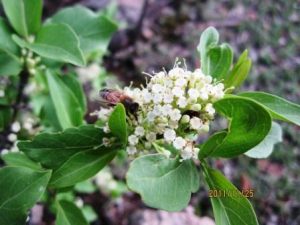
Psydrax livida . Photo: Bart Wursten. Flora of Zimbabwe
The miombo woodland contained many familiar species: quite common for example was Pittosporum viridiflorum, Monotes glaber, still showing its distinctive greenish-yellow leaves, Psydrax livida (the so-called green twigs) and Combretum molle and collinum.
The termite mounds themselves were frequently densely covered with the rigid spine-tipped leaves of Sansevieria pearsonii, a plant which can be rather dangerous to walk though as it can easily pierce one’s legs.
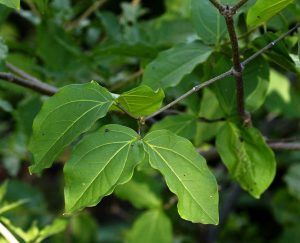
Strychnos potatorum. Photo: Bart Wursten. Source: Flora of Zimbabwe
The termite mounds also had the usual rich flora typical of such places. We saw Boscia salicifolia with its narrow willow-like leaves, Maerua triphylla with its 3-foliolate and Strychnos potatorum with quilted, deeply-veined leaves. Also the thickly-textured leaves of Mystroxylon aethiopicum, a climbing jasmine and Euphorbia ingens. A stout climber with succulent leaves defeated me as it lacked flowers or fruits; perhaps it was a species of Senecio?
Growing on a Msasa was a large woody “Loranthus” with thickly textured, slightly glaucous, leaves and red fruits. Two things of interest were discussed at this point. Firstly – were the parasite’s leaves colder than those of the host tree? Opinions differed until John Lawrence applied the cheek test- holding a parasite leaf to one cheek and a Brachystegia leaflet to the other. This showed that the former were significantly colder and reversing the samples provided further confirmation.
The fruits themselves had a large “pip”, surrounded by a sticky layer and on the outside a thin red skin. John explained how as a boy he used to use the sticky fluid as “birdlime”. The technique is, apparently, take a whole lot of fruits into one’s mouth, then draw a piece of grass through the mouth to make it sticky. Next put down some bait and surround the bait with the sticky grass. Small birds then get their feathers caught in the sticky leaves.
At the river, we encountered a rather different selection of trees. Here we were in more open woodland just below the dam wall next to quite a wide expanse of water. At the edge was Zanthoxylum capense (known, I suspect to some members as Fagara capensis). This species has 1-pinnate leaves with the larger leaflets towards the apex and strong spines on the leaf itself making picking it a painful process. The species belongs to the family Rutaceae and has translucent gland dots in each leaflet lamina. It can be recognized by the fact that the glands are concentrated around the leaf margin as opposed to being scattered though the lamina.
A slightly more unusual plant seen was Helinus integrifolius. This is a climbing woody species with tendrils from the family Rhamnaceae; it does occur in riverine vegetation, but I don’t remember seeing it so close to Harare before.
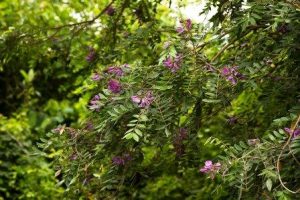
Mundulea sericea. Photo: Bart Wursten. Source: Flora of Zimbabwe
Further on we encountered a specimen of Vangueria randii covered in fruit, Ficus natalensis and Rhus quartiniana. Also present was Mundulea sericea; some forms of this are distinctly garden-worthy with strongly-coloured flowers. Today, however we only saw fruiting specimens. We also found the palmate leaves of Vitex payos, several small trees of Swartzia madagascariensis and Gardenia ternifolia. Also present was the low-growing Rhus kirkii with its brownish-hairy leaves.
Later on, the conversation turned to snakes and shortly afterwards – on cue – someone spotted one, on the ground, eating a frog. It was quite small and coloured green. On seeing us it surged up a small Monotes tree and did a twig impression amongst the Monotes leaves; but as it was at about head height we got a very good view of it. The body had a distinct bulge where the frog was being digested.
At this stage we turned back, but a small rocky area by the road caught our attention and we came across a further selection of species. One species, more usually a shrub in my experience, was Erythrococca trichogyne (the twin berry). The leaves are simple and alternate without latex and the species can look a bit anonymous. It is from the family Euphorbiaceae.
Also amongst the rocks were several fine specimens of Rothmannia fischeri. Although not a rare species, it is still nice to see it and to admire its domatia; these consist of hairy pits in the axils beneath and raised domes above. On this occasion they could be seen to be translucent as the sun shone though the leaves above our heads.
Lunch was long, an opportunity to catch up with other people’s news; indeed so long that there was no afternoon walk and at 3.30 p.m. we packed up and left. All in all, a very enjoyable day with some most interesting trees and plants seen.
-Mark Hyde
I forgot to mention that we found a fine specimen of the Deviltjie, Tribulus terrestris growing by the Seke Road at the turn off to the dam. It has fine yellow flowers and paired, pinnate leaves on opposite side of the stem; the leaves are anisophyllous, i.e. of unequal size. It is more a species of middle to low altitudes but one gets the impression it is increasing around Harare.
An extract from ‘Do plants love animals that eat them’ By Peter Jackson and Eugene Moll.
From ‘Veld & Flora March 1985 with thanks.
EFFECT OF SPINESCENCE ON BROWSING.
Recent work in East Africa on the effect of spinescence (frequency of spines and thorns) on browsing has revealed interesting hypotheses. It has long been considered that spinescence had evolved to prevent browsing and that non-spinescent plants have secondary chemical compounds in their leaves that make them unpalatable. These two strategies that have evolved in plants also tell one something about soil nutrient status. Plants growing on soils poor in available nutrients tend to be evergreen, non-spinescent and hence have leaves loaded with chemical defenses.
Recently much publicity was given to work at Pretoria University which indicated that excessive defoliation by browsing leads to a dramatic increase in the chemical loading in leaves. It was also suggested that plants could “send messages” to adjacent individuals of the same species – by way of some volatile chemical substance – to induce them to increase their secondary compounds and so avoid defoliation (browsing).
On the other hand, plants on nutrient-rich sites are able to invest expensive energy in spines, since nutrients are easier to obtain. It has been shown that these spines do not prevent defoliation, but rather regulate the rate at which it can occur, thus imposing a limit on the degree of utilization. In the genus Acacia some species have pods that are dehiscent while others are indehiscent i.e. do not split spontaneously when ripe. The seed coat of the indehiscent species, the pods of which are eaten by herbivores and thus dispersed, are therefore significantly thicker to prevent them being digested.
All this goes to demonstrate that plants and animals have co-evolved, each being dependent on the other. Imbalance is only produced when technological man interferes with the naturally evolved system. The final question “is this all true?” can only be asked by you. But it makes you think.
References supplied.
Does Jonathan Timberlake have a comment?
In Retrospect Continued. By Lyn Mullin
BLOSSOM TIME
Under this heading TREE LIFE Nos 126 & 127 (August-September 1990) carried very interesting extracts from A Field Guide to the Wild Flowers of the Witwatersrand and Pretoria Region, by Braam van Wyk and Sasa Malan (Struik Publishers) ISBN 0 86977 814 5. Many of the plants described in this publication may be found in Zimbabwe.
WHITE OR WHITISH FLOWERS
White coloration in flowers is due mainly to multiple reflections of light by air spaces between colourless cells in the petals. It is a physical phenomenon (comparable to combing water or snow) and no white pigments are involved. Many white flowers, however, contain a variety of flavonoid (yellowish) pigments which, to the human eye, may impart an ivory or cream coloration to the flower. These pigments absorb ultraviolet light which, although not perceptible to the human eye, is clearly visible to insects. To insects, white flowers might, for example, appear blue-green or yellow. White petals with a uniform reflection of light throughout the visible and near-ultraviolet spectrum have seldom been found. This suggests that, in the eyes of an insect, white-coloured flowers are probably extremely rare.
White flowers are visited by a large variety of insects, especially bees and moths, but also flies, butterflies, and beetles. Regular white flowers with an exposed disc are often fly-pollinated. Flowers pollinated by hawk-moths (Turraea spp, Gardenia spp) are almost always whitish (sometimes with a yellow or pink tinge), and have abundant nectar in long, narrow tubes. They lack nectar guides, emit a sweet, heavy scent at night, and often close during the day.
YELLOW OR CREAM FLOWERS
Most yellow flowers owe their coloration to the carotenoid (orange or yellow) and flavonoid (yellow) groups of pigments. Often present as droplets or in granular or crystalline form, carotenoids are enclosed in numerous, discrete bodies, called chromoplasts. Flavonoids are soluble in water, and colour the cell sap.
Yellow flowers attract all the main groups of insect pollinators. Bees and some butterflies (particularly the nymphalids) show a strong preference for this colour group. Flowers that attract bees are usually irregular, and characterized by nectar, nectar guides, and few stamens. Those pollinated by butterflies have a slight scent, and their nectar is well hidden in narrow tubes and spurs. Ultraviolet reflection is often found in yellow flowers. To insects, yellow may appear purple, red-purple, or red.
PINK TO RED OR RED-PURPLE FLOWERS
Colours of flowers in the range from pink to red to purple to blue usually result from the presence of anthocyanins, a group if pigments belonging to the same class of chemicals as the yellow flavonoids. Anthocyanins dissolve in the cell sap and can vary, depending on the Ph of the solution. If it is very acid, the colouring is most likely to be red, whereas if it is more alkaline, the pigment tends towards blue.
Red flowers are most often associated with pollination by sunbirds (Erythrina spp) and certain butterflies, particularly the swallowtails and the whites. Bees and most other insect pollinators are red-blind and, in theory, should not be attracted to red colours. However, in nature, many red flowers are visited by bees, which are attracted by the ultraviolet light that the flowers reflect, rather than by the red. In addition, red-purple and most red flowers contain a blue component, and this is visible to the bees. It has also been shown that bees can be trained to respond to red colours, even those of flowers that typically attract birds.
Birds have a colour vision very similar to that of humans, except that they react less strongly to blue or violet, and are more sensitive to red. They also resemble humans in that they are blind to ultraviolet light. To most insects, bright red flowers that do not reflect ultraviolet light, for example, appear dull grey, while those reflecting ultraviolet are likely to be perceived by them as blue.
BLUE OR BLUE-PURPLE FLOWERS
Anthocyanins dissolved in the cell sap are responsible for the blue and blue-purple colouring of the flower petals. The colour that they produce varies according to the Ph of the sap, being red in an acid solution and blue in a more alkaline one.
Bees visit blue flowers more frequently than does any other insect group, and irregular blue flowers, in particular are nearly always bee-pollinated. To bees, blue and blue-purple probably represent one single colour, and may be perceived as green. Through the eyes of insects the green foliage of plants is believed to be a dull yellow-grey, a neutral background against which the insect-green flowers would contrast vividly.
ORANGE TO RED-BROWN FLOWERS
Orange colours are often due to the presence of carotenoid (orange or yellow) pigments in the cells of the petals. The darker brownish or maroon colours may be the result of several pigments, such as the carotenoids, anthocyanins, and chlorophyll occurring in the same cell, or in different cell layers lying on top of one another.
Flowers in this colour group are visited by a large variety of insects, including bees and wasps. Moths may pollinate some of the tubular brownish flowers, and flies are attracted to the carrion smell of the brownish-red members of the Asclepiadaceae family. Birds’ sensitivity to red flowers is not exclusive, and some of the tubular and nectar-rich orange flowers are very popular with sunbirds (Aloe spp, and Halleria spp). To insects, orange may appear red to purple. Brownish colours are not particularly attractive to them, and many such flowers appear to rely on scent to attract pollinators, especially moths at night (bulrushes, for instance).
GREEN OR GREENISH FLOWERS
Green floral colours are usually produced by chlorophyll, the pigment also responsible for the green colouring of leaves. Insoluble in water, chlorophyll occurs with other substances in roundish, green bodies called chloroplasts, which are distributed throughout the green parts of the plant. Photosynthesis takes place in the chloroplasts, and in this process the chlorophyll is of paramount importance in trapping a portion of the light energy radiated from the sun.
Pollinators that visit green flowers include flies (Ziziphus spp), bees, and moths. Although some pure green flowers are not easily seen by insects, and depend on odour to attract pollinators, others may be scentless, and rendered conspicuous by the presence of pigments reflecting ultraviolet rays. In the absence of ultraviolet effects, green flowers are probably perceived by insects as dull yellow-grey, thus blending with the similarly coloured background of foliage.
“Make Thee an Ark of Gopher Wood.” Genesis 6 : 14)
What is ‘gopher wood’? What tree did Noah use in the construction of his ark? Weight of opinion favours the common cypress of the Mediterranean region. This cypress, called Cupressus sempervirens is known to have been found growing plentifully in the mountainous parts of Biblical lands.
The wood of this cypress tree is hard and durable, and has been much used since earliest times. Idols were carved from it; the ancient Egyptians used it for mummy cases and coffins; temples were roofed with it; musical instruments were constructed from it. The doors of St. Peters in Rome are made of cypress wood and after 1200 years, show no signs of decay.
Noah’s Ark may have been one of the first ‘ships’ to be built of cypress wood. It certainly was not the last. Cypress was used extensively in ship building by the Phoenicians who were the greatest seamen and traders of their time, and later by the Cretans and the Greeks. Alexander the Great, mighty conqueror of the Persian Empire in the 4th century B.C., had a great fleet at his command. It is recorded that his galleys were made of cypress. They were long, narrow boats propelled by oars, and had as a rule about 50 oars, each worked by six men, usually captive slaves.
We do not know why Cypress trees became a symbol of death and mourning. They were planted in cemeteries first in those of the followers of Mohammed in the eastern Mediterranean, and later in the cemeteries of Western civilisation, Venus mourning Adonis wore a wreath of cypress.
The island of Cyprus is said to have been named after the cypress tree which was worshipped on the island by Aphrodite, goddess of love and beauty in Greek mythology, who was also called Cypris. There are other stories associated with the sanctity of the cypress, Zoroaster, the great religious teacher who lived in 800 B.C. founded a sect of Persian fire-worshippers who planted certain cypress trees at their temples, because the cone-like shape of the trees suggested fires to them. Zoroaster himself lived under a cypress tree. The Parsees in India still follow the religion of Zoroaster and worship fire.
Here are two legends of the cypress tree which come down to us.
‘The Greek god Apollo was very fond of a mortal boy named Cyparissos, who in turn was greatly attached to a tame stag that grazed on sacred Ceos. One day Cyparissos accidentally killed his playmate stag and, overcome with grief, he begged the gods to let him mourn forever. Thereupon Apollo transformed him into a cypress tree in which guise he still mourns.’
‘The earth goddess, Ceres, plugged the crater of Mount Etna with a huge cypress trunk and thereby imprisoned forever the fire god, Vulcan, at his forges beneath the mountain. Eruptions of Etna were regarded as attempts of Vulcan to escape his imprisonment.’
The Cypress is a cone-bearing tree. The flowering season is in the winter and it is recorded that the abundant pollen produced during the period June to September is a cause of winter hay-fever where the trees are common.
Cypress trees grow well in Europe. One of them in Lombardy in northern Italy, is said to be the oldest tree in Europe. It is 120 feet high with a trunk circumference of nine feet. It was known to be a good-sized tree at the time of Julius Caesar, Napoleon, was so impressed with it that he spared it when he built his road through the Simplon Pass.
Adapted with thanks from Gertrude Ordman’s article in ‘Trees in South Africa . April-June
THE NEW COATES PALGRAVE: A MOST PRODIGIOUS WORK
Keith Coates Palgrave: Trees of Southern Africa. New Edition (2002) Revised and updated by Meg Coates Palgrave. Published by Struik, Cape Town.
It was with considerable trepidation that I agreed to write a review of the new CP for TREE LIFE. How does one review an update of what is essentially the “bible” of Southern African tree books? Perhaps we could begin with a few statistics.
This third edition of Trees of Southern Africa is a BIG book. It runs to 1212 pages against the 958 pages of the first edition, and it weighs 2.35 kg on our kitchen scale, compared with 1.55 kg for the first edition (the paper used for the new edition is a bit thicker than that of the first edition, which would account for some of the increased weight). So it is strictly a book for examining at a table or desk, not for carrying around in the field or on Botanic Garden walks. The taxa treated in the new edition have not been counted by me, but there seems to be a substantially greater number than in the first edition. The species distribution maps have been updated and redrawn on a smaller scale than in the first edition, but they are perfectly clear and informative. The black-and-white photographs of the first edition have been omitted from the new work, but the colour illustrations have been retained and the drawings of characteristic leaves and/or fruit are in most cases the same as before, but some are new, eg for Ficus tremula and the subspecific taxa of Salix mucronata.
Recent changes of family names are reflected in the new CP, eg the genus Aloe is now placed under Aloeaceae, not Liliaceae; Celtis is now in Celtidaceae, not Ulmaceae; Myrianthus is now in Cecropiaceae, not Moraceae; and so on. In recent years there have been a number of changes of generic and specific names among our trees, which, although irritating in the case of well-known species, simply have to be accepted, and the new names learnt. The new CP reflects most of these changes, but it seems that southern African botanists have rejected a recent move to take Podocarpus falcatus out of the genus Podocarpus and include it in the new genus Afrocarpus. The new CP sticks to Podocarpus falcatus.
Species descriptions have been revised where necessary, and there are new leaf keys for the major genera, i.e. those with a fair number of species. The key to the families at the front of the book has been comprehensively revised, and runs to 46 pages, against the 21 pages of the first edition. None of these keys has been tested for this review, but reading over some of them suggests to me that it will be much easier to identify a species from the new CP than from the old. I have to confess that I had too much difficulty with the keys in the old CP, and would not use them.
Eight new taxa or combinations are published in this work, one of them of relevance to Zimbabwe-or is it? The plant is Gymnosporia polyacantha ssp vaccinifolia, formerly G. vaccinifolia. The type is from Modderfontein, Gauteng Province, in South Africa, and although it has been given an English common name for Zimbabwe there is no indication in the text or the distribution map that the species actually occurs in this country. A Zimbabwe National Tree Number has not been given. Two other little “glitches” came to my notice: Boscia matabelensis appears in bold in the index, and is indicated for page 227, but it does not appear anywhere in the text on that page. Inadvertent omission? It does not appear in the leaf key for the genus on page 224, but it is mentioned under B. mossambicensis on page 228. The second little glitch, a very minor one, has Gymnosporia harveyana, on page 609, out of the alphabetical order of species within the genus. This latter appears to have been a very last-minute change to take account of a revision of what was formerly G. mossambicensis.
As in the case of the first edition of Coates Palgrave, each species has, besides its Latin botanical name, an English common name, and (for South Africa) an Afrikaans name. Common names are not an easy subject, particularly in countries like Zimbabwe where English is a recently introduced language, and English names of plants all-too-often reflect the names of apparently similar-looking species in the “home country”. However, there are many people, even within the Tree Society, who have difficulty getting to grips with Latin binomials and will welcome the continued use of English names for our trees. I, personally, find some of the English names that appear in this and earlier editions of CP to be more cumbersome than the Latin binomials, but this in no way detracts from the value of the work or from the immense contribution the revising author has made in the field of botanical knowledge in Southern Africa. She has successfully completed a task that would have daunted most people, and must now be the envy of all.
If I could have asked for the inclusion of anything in this great work, it would have been a brief note on the derivation of the botanical and common names of each species. This would have added immensely to the research required for the book, and immeasurably to the value of the completed article.
Finally, for most of us in this era of hyperinflation, the real nitty-gritty. How much does the new CP cost? I was fortunate in having someone in Pretoria who could organize a copy for me direct from the publisher at a cost of R295.95, and someone else who could bring it to me in Harare on return from a business trip. My understanding is that the book is retailing in South Africa for R299.00. But what will the retail price be in Zimbabwe? I have no idea, except that it won’t be cheap! For those who have access to forex and want the book-get it! It is worth every cent, and will give much pleasure for very many years. Just as an afterthought, my copy of the first (1977) edition of CP cost me ZW$13.13-the retail price is still clearly visible.
-Lyn Mullin
This issue of Tree Life has kindly been sponsored by the actuarial firm Pentact (Pvt). Ltd.
MARK HYDE CHAIRMAN


